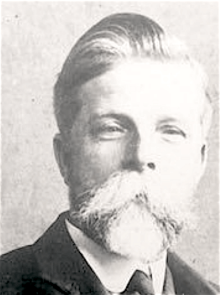
George John Skipper [also known as G.J. Skipper] was born in East Dereham, Norfolk, England, on 6 August 1856. His brother, Frederick Wilemer Skipper, his uncle, Eric Haywood Skipper, and his son, Edward Goodwin Skipper, were all architects. G.J. Skipper studied at Norwich School of Art in Norwich, Norfolk, in 1872 and between 1873-76 was articled to John Thomas Lee (c.1845-1920). He then worked in a builder's and contractors office until 1879 [or 1881 - sources differ] when he set up his own independent practice in East Dareham.
In 1880 Skipper relocated to Norwich, where for many years he was to become a leading proponent of the Arts and Crafts and later neo-Baroque styles of architecture. From 1889-1912 he was in partnership with F.W. Skipper.
He was elected a Fellow of the Royal Institute of British Architects (FRIBA) in 1889. He was also a Member of the Town Planning Institute (MTPI) and onetime Vice-President of the Norfolk & Norwich Architectural Association. In addition to his work as an architect, Skipper was also a painter and exhibited at the Royal Academy in London between 1906-32. He died in Norwich on 1 August 1948.
Sexey's Trade School, Bruton, Somerset (1882-91); Crispin Hall, Street, Somerset (1885); Millfield School, Street, Somerset (1888-89); Grand Hotel, Cromer, Norfolk (1891); Hotel Meytopole, Cromer, Norfolk (1893); Sandcliff Hotel, Runton, Cromer (1895); Hotel de Paris, Cromer, Norfolk (1895-96); Hunstanton Town Hall, Hunstanton, Norfolk (1896); Mancroft Towers. near Oulton, Suffolk(1898-1900); Royal Arcade off Market Place, Norwich (1899); Norfolk Daily Standard offices, St. Giles' Street, Norwich (1899-1900); the Royal Norfolk and Suffolk Yacht Club in Lowestoft (1903); the the University Arms Hotel in Cambridge (1903); Norwich Union Assurance headquarters building, Surrey Street, Norwich (1903-04); Jarrold's department store, Exchange Street and Market Place, Norwich (1903-05); frontage of Telephone House at 43 and 49 Giles Street, Norwich (1906); the London & Provincial Bank in Norwich (1907); and the Norwich Union branch office in Cambridge (1909). Other projects included the Town Halls in Cromer, Framingham, Lowestoft and Hunstanton in Norfolk; cottages for King George V at Sandringham; the Red House in Cromer; the Bulwer Memorial in Heydon; Gostwyck Grange in New South Wales, Australia; offices for Jerrold & Sons in Norwich; Wyman & Sons' Printing Works in Fakenham; Maltings for Messrs Swonnell in Oulton Broad; offices for the Ipswich Malting Co. in Ipswich; Cliff Hotel in Gorleston; Sheringham Hotel in Sheringham; Centre Cliff Hotel in Southwold; Victoria Mansions Hotel in Lowestoft; ; Knapton School; the Colliery Village for the Chislet Colliery Co., near Canterbury, Kent; the covered cricket pitch and cottage for Harrow School; premises for the British Gas Light Co. in Norwich; the Elms Estate for Messrs Caley & Sons, Norwich; works for H.H. Prince Frederick Dunleep Singh, etc. Skipper was architect and surveyor to East Dereham Urban District Council, Blofield and Aylsham Rural District Councils, as well as seven other councils.
See also
'Obituary'. RIBA Journal vol. 55, 1948 p.519
'Obituary'. The Builder vol. 175, 13 August 1948 p. 183
Barnes, Richard. George Skipper : the architect's life and works. Norwich : Frontier, 2020.
Bussey, David and Martin, Eleanor. The Architects of Norwich: George John Skipper, 1856-1948 Norwich, England: The Norwich Society, 2012
Directory of British Architects 1834-1914. Compiled by Antonia Brodie, et al. Volume 2: L-Z. London; New York: British Architectural Library, Royal Institute of British Architects/Continuum, 2001
‘George Skipper (1856-1948)’ Architectural Review vol. 159, no. 949, March 1976 p. 129.
George Skipper 1856-1948: architect exuberant. Norwich, England: Norwich School of Art, 1975 [Exhibition catalogue]
Gray, A. Stuart. Edwardian architecture: a biographical dictionary. London: Gerald Duckworth & Co., Ltd., 1985
Jolley, David. ‘George Skipper’. Archaeological Journal vol. 137, 1980, pp. 321-322.
Who’s Who in Architecture 1914 London: Technical Journals Ltd., 1914
Who’s Who in Architecture 1926. Edited by Frederick Chatterton. London: The Architectural Press, 1926